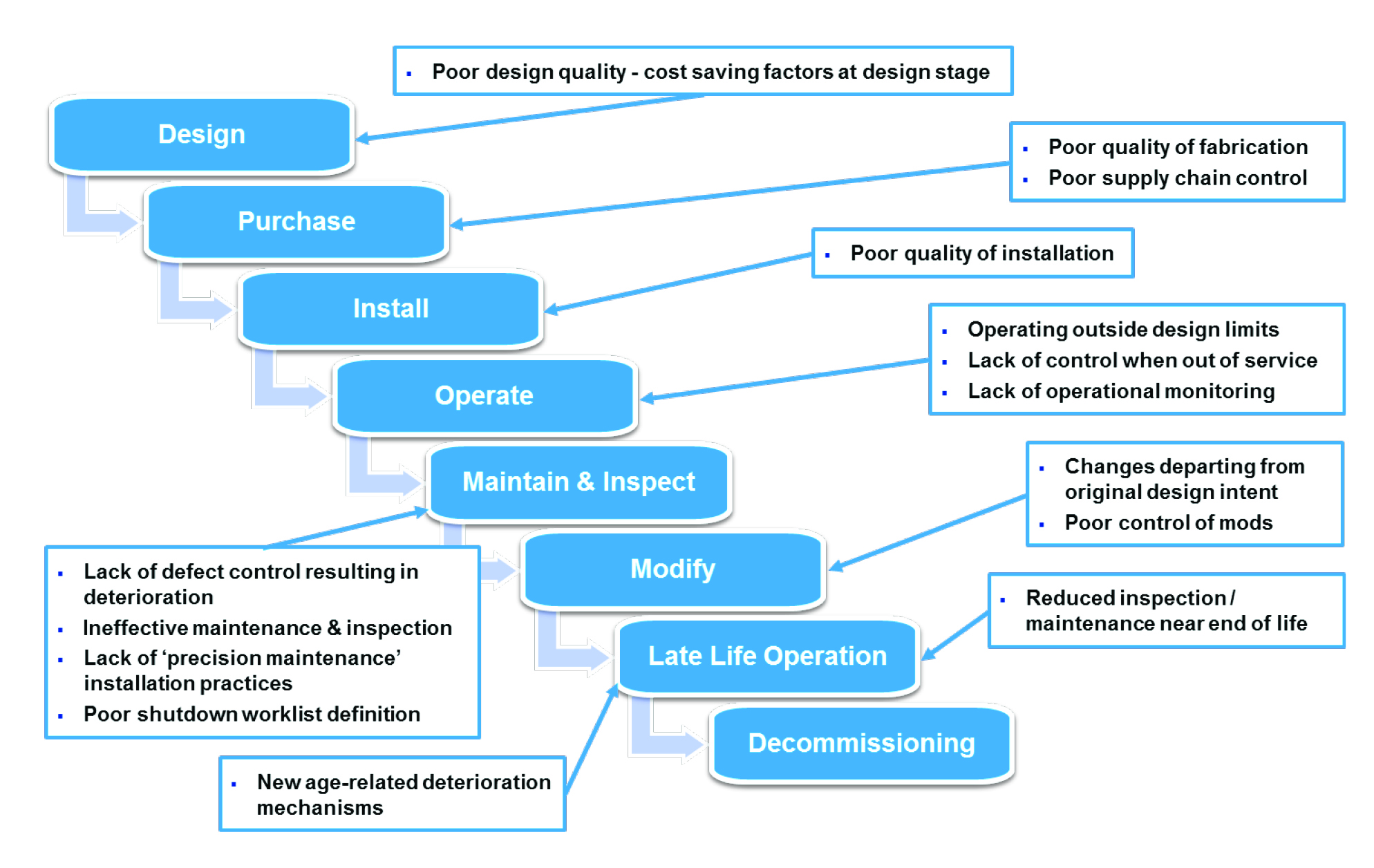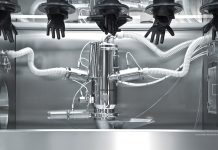1. Introduction
Many of the high hazard chemical plants in the UK have been in operation for 30 to 40 years. The original design life of the facility has now been, or is about to be exceeded and the case for continued operation needs to be demonstrated to both stakeholders and the regulators.
2. Ageing
The actual age of the equipment is not however, in itself, a sound basis for assessing its suitability for continued operation. Ageing encompasses a multiplicity of physical, operational and engineering factors that have a significant influence upon the life of the equipment, as can be seen in Figure 1.
From Figure 1 we can see that some life limiting factors were designed, either intentionally or inadvertently, into the asset long before it started operation generally in response to capital cost considerations. However, ABB Consulting’s investigations have identified operating and maintenance practices as the root cause of circa 50% of failures. These are, or should be, within the current control of the operator and, perhaps more importantly, can be managed into the future.
Key to the ongoing safe and reliable operation of the equipment is therefore gaining a clear understanding of the equipment, its current condition and the rate of deterioration. This not only establishes whether the equipment will continue to be fit for purpose but also helps us to identify what needs to be done to manage its integrity, as it continues to age. The practical application of these concepts underpins ABB’s methodology.
3. Asset Life Studies of Chemical Plants
These studies are aimed at the identification of the short, medium and longer term actions and costs for continued operation.
The study focuses on the vulnerability of the systems and equipment to ageing and potential life limiting issues, such as deterioration mechanisms and obsolescence. It is based on existing information provided by the asset operator, both recorded and gained from discussions with engineering personnel. This is supplemented by visits to the asset for discussions with operations and maintenance personnel, and to undertake surveys.
The study reviews the physical condition of the equipment and considers the role of asset care in sustaining equipment life. This includes predictive measures (inspections) and preventative actions (such as planned maintenance, painting and care of insulation) to maintain the facility in an operable condition into the future.
The objectives for these studies vary from operator to operator and from asset to asset reflecting a range of operational and commercial considerations. Typical objectives are:
• To investigate and document the condition of the plant and equipment, in order to identify issues likely to interrupt operation during the remaining life of the asset.
• To determine the additional investment costs required to keep the asset running for defined periods of operation. (e.g. 10, 15, 20 and / or 25 years).
• To minimise the cost of inspecting and maintaining the equipment during the late life phase
• To identify prioritised actions to address asset life issues identified as “gaps”.
In assessing the ability to continue to operate the equipment over its projected life there are a number of key questions that the specialist functional consultants need to be able to answer. These are summarised below.
• Will the equipment continue to be fit for purpose until it is no longer required?
• If not what needs to be done about it?
– How much additional expenditure is necessary over the remaining operational life?
– What does it need to be spent on? (targeting)
– When do the actions need to be completed? (planning)
– Which are the most important things to do? (prioritisation)
– What is the potential cost / risk if the action isn’t done? (criticality)
– How quickly can we recover the situation should the equipment fail? (vulnerability)
4. Methodology
The scope of any study can vary significantly in both scale and focus, from a whole site down to a study on a particular plant area, or class of equipment which may be of concern to an operator.
A Plant Study is delivered by a team of specialist functional consultants covering the full range of specialisms, including pressure systems, rotating equipment, electrical, control and instrumentation, civil and structural. The team follows an established, proven and flexible methodology for delivering Asset Life Studies. The process is outlined below.
4.1 Identification of the assets and equipment in scope
The starting point for any study is to identify the assets to be covered by the study.
At the next level it is necessary to find out which equipment is located within, or associated with, which system. The common facilities and utilities are also identified.
Within each of the systems and the common facilities it is necessary to identify which equipment is in service and what date it is required to operate to, recognising that some of the equipment may be redundant or retired early.
On the basis of this information the study team are then able to determine how to approach the assessment of the equipment. For example, larger items of equipment, such as pressure vessels, are generally assessed individually while instrumentation is often treated as a population.
4.2 Information Collection
The information necessary for the study is assembled from a variety of data sources including asset registers, drawings, photographs and the inspection and maintenance records. This is supplemented by discussions with the operations and maintenance personnel responsible for the asset. A site visit allows a visual survey of the equipment.
4.3 Assessment and Categorisation of the Equipment
An assessment is made of the ability to continue to operate the equipment to its projected retirement date. This assessment is based upon knowledge of the current condition of the equipment, the known / likely deterioration mechanisms and other life limiting factors (such as obsolescence) and the ability to maintain the equipment in a reliable and serviceable condition over the operational life of the asset, and beyond. The assessment draws heavily upon the knowledge and experience of the specialist consultants.
A key output of the assessment is a confirmation of the ongoing maintenance and inspection requirements for the equipment. The assessment also establishes whether the necessary measures are in place.
The asset life status of the equipment is then defined and categorised as described below.
A Equipment requiring replacement within the remaining operational life of the asset
B Equipment requiring major repair for continued operation
C Equipment requiring additional minor (but significant) repair for continued operation
D Equipment for which continuation of maintenance and inspection regimes is sufficient
E Equipment requiring further information / study
Categorisation of Equipment Asset Life Status
Typical examples of category A include the replacement of vessels, pump sets and safety systems (i.e. a major upgrade of a fire and gas system). Category B typically includes major repairs to vessels and tanks, the replacement of sections of pipework and extensive fabric maintenance. Minor modifications, and localised repainting and re-lagging are examples of category C.
Category D covers the equipment for which continuation of the existing maintenance and inspection regimes is deemed to be sufficient to maintain the equipment in a reliable and serviceable condition. .
It is not always possible to determine the asset life status of all of the equipment. More detailed inspection and / or specialist studies may be necessary to provide sufficient knowledge upon which to base the assessment. Category E captures this equipment.
Figure 2 (see page 32) shows a typical Asset Life Categorisation.
In this particular example it can be seen that the bulk of the equipment (65%) could be sustained with continuation of the existing maintenance and inspection regimes (Category D). In addition some 7% of the equipment requires minor, but nonetheless significant repair / refurbishment.
17% of the equipment will need to be replaced or will require major repairs / refurbishment. Categories A and B represent the majority of the expenditure.
4.4 Identification of Gaps and Recommendations
The identification of the gaps is based upon a comparison of the measures required to sustain the safety and reliability of the equipment over its projected operating life. The annual maintenance programmes and the turnaround programme are important inputs into this process.
Most assets have an ongoing fabric maintenance campaign. Understanding the scope of this programme and the rate of progress relative to the size of the overall task is also important. This is, in effect, a judgement as to whether the operator is managing to paint the asset faster than it is rusting!
In addition to this the project programme is reviewed to identify projects covering major maintenance (replacements and refurbishments) and any planned modifications.
Having completed this comparison the recommendations to address the gaps can then be formulated.
4.5 Estimation of the Cost to Implement the Recommendations
The cost of implementing each recommendation is estimated. Any assumptions made in order to produce the estimates are recorded with the recommendation, together with equipment costs and the installation factors used.
4.6 Prioritise the Recommendations and Propose the Recommendation Timescale
Prioritisation and timing of the recommendations involves striking a balance between risk and an assessment of when it is practicable to have completed the recommendation. The risk assessment includes HSE risk and business risk. The risk assessments are based upon the operator’s risk assessment word models used within their business.
4.7 Full List of Recommendations
The full listing of recommendations produced by the study is provided as a spreadsheet. This forms the basis of asset remediation projects.
4.8 Finalisation of the Equipment Asset Life Plans
Having validated the study findings and recommendations the specialist consultants are then able to complete the asset life plans. The asset life plan includes a description of the equipment, its specification and construction, together with a summary of the operation and maintenance history with a particular emphasis on the age related deterioration mechanisms. The plan also records the findings and outcome of the risk assessment and the asset life categorisation. The plan gives an authoritative review of the equipment and states what actions are necessary for the continued safe and reliable operation of the equipment for the remaining life of the asset. A list of the recommendations to address the identified gaps is appended to the plan.
In summary each asset life plan is a clear statement of the way forward for the equipment.
4.9 Generation of the Expenditure Projection
The data within the recommendations spreadsheet is used as the basis for the creation of the expenditure projection
4.10 Reporting
A report summarising the findings of the study, including the consultants’ comments on the status and future operation of the equipment, is prepared. The recommendations spreadsheet and the individual equipment asset life plans form part of this report.
4.11 Implementation Planning and Embedding
Key to realising the benefits of the Asset Life Study is the planning and implementation of the recommendations and findings. Further detailed studies may be required to firm up on obsolescence and replacement projects and maintenance and inspection scope and practices may need to be adjusted. Future improvement projects will require scoping, designing and implementing and changes will be made to the scope of forthcoming turnarounds.
Most important however is to embed the change of mind set across the operation to consider the impact of ageing assets on all aspects of the business.
5. Benefits
Asset Life Studies provide one of the essential inputs to the strategic business planning process for the asset. The cost information and expenditure profiles are valued by the operator.
The studies also provide confirmation of the technical feasibility of sustaining ongoing operation, as well as the technical justification for the safety of continued operation to the Regulator and the stakeholders.
From an engineering standpoint, they identify the full programme of work required to sustain the operation of the asset. They also improve the understanding of equipment ageing issues and the measures required to manage them within the operations and engineering teams.














